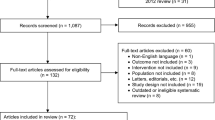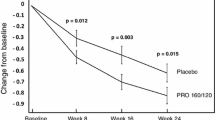Abstract
This double-blind multiclinic crossover study was performed in order to compare the efficacy and tolerance of a 4-week treatment course with flavoxate, given orally at 1200 mg/day, with that of oxybutynin, 15 mg/day orally, in women with idiopathic motor or sensory urgency. Fifty patients were included in the study: 41 (20 affected by sensory urgency and 21 by motor urgency) completed both courses of treatment and were evaluated for efficacy utilizing clinical and urodynamic criteria. Diurnal and nocturnal frequency, diurnal incontinence, urgency, dysuria, and daily utilization of pads were comparably reduced by both treatments. A statistically significant improvement in all urodynamic parameters was present at the end of both treatment courses. The effect on the urodynamic parameters of the two treatments was comparable. According to the patients, flavoxate cured or greatly improved the syndrome in 81.6% of cases, while oxybutynin produced the same effects in 78.9%. The difference in efficacy between the two treatments was not statistically significant. Of the 41 patients who received both treatment courses, 11 (26.8%) experienced adverse reactions with flavoxate, and 37 (90.2%) with oxybutynin treatment. Moreover, 5 patients, not included in the efficacy evaluation, interrupted the treatment because of side effects while taking oxybutynin, whereas no patients stopped while taking flavoxate. The severity of the side effects recorded during oxybutynin treatment was significantly greater than during treatment with flavoxate. Flavoxate showed comparable efficacy to oxybutynin in relieving the urge syndrome, but was associated with fewer and milder side effects.
Similar content being viewed by others
References
Da Re P, Verlicchi L, Setnikar I. Some basic derivatives of 3- methylflavone-8-carboxylic acid. J Med Chem 1960; 2:263–269
Cazzulani P, Panzarasa R, Luca C, Oliva D, Graziani G. Pharmacological studies on the mode of action of flavoxate. Arch Int Pharmacodyn Ther 1984; 268:301–312
Cazzulani P, Panzarasa R, De Stefani C, Graziani G. Mechanism of flavoxate antispasmodic activity. Comparative in vitro studies. Arch Int Pharmacodyn Ther 1985; 274:189–200
Ruffmann R, Sartani A. Flavoxate, a drug with smooth-muscle relaxing activity. Drugs Exp Clin Res 1987; 13:57–62
Ruffmann R. A review of flavoxate hydrochloride in the treatment of urge incontinence. J Int Med Res 1988; 16:317–330
Abbiati GA, Ceserani R, Nardi D, et al. Receptor-binding studies of REC 15/2053 and other bladder spasmolytics. Pharm Res 1988; 5:430–433
Milani R, Scalambrino S, Carrera S, Pezzoli P, Ruffmann R. Flavoxate hydrochloride for urinary urgency after pelvic radiotherapy: comparison of 600 mg versus 1 200 mg daily dosages. J Int Med Res 1988; 16:71–74
Milani R, Scalambrino S, Carrera S, Pezzoli P, Ruffmann R. Comparison of flavoxate hydrochloride in daily dosage of 600 versus 1 200 mg for the treatment of urgency and urge incontinence. J Int Med Res 1988; 16:244–248
Pocock SJ. Crossover trial. In: Clinical trials: a practical approach. Chichester: Wiley and Sons, 1983: 110–123
Williams ME, Pannil C. Urinary incontinence in the elderly. Ann Intern Med 1982; 97:895–907
Millard RJ. Urinary incontinence: an analysis of incontinence in the general population. Drugs 1988; 35:477–494
Andersson KE. Current concepts in the treatment of disorders of micturition. Drugs 1988; 35:477–494
Moisey CU, Stephenson TB, Brendler CB. The urodynamic and subjective results of treatment of detrusor instability with oxybutynin chloride. Br J Urol 1980; 52:472–475
Gajewski JB, Awad SA. Oxybutynin versus propantheline in patients with multiple sclerosis and detrusor hyperreflexia. J Urol 1986; 135:966–968
Author information
Authors and Affiliations
Rights and permissions
About this article
Cite this article
Milani, R., Scalambrino, S., Milia, R. et al. Double-blind crossover comparison of flavoxate and oxybutynin in women affected by urinary urge syndrome. Int Urogynecol J 4, 3–8 (1993). https://doi.org/10.1007/BF00372799
Issue Date:
DOI: https://doi.org/10.1007/BF00372799




